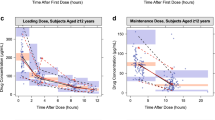Abstract
Objective: The pharmacokinetics and non-linear red blood cell partitioning of the nucleoside transport inhibitor draflazine were investigated in 19 healthy male and female subjects (age range 22–55 years) after a 15-min i.v. infusion of 1 mg, immediately followed by infusions of variable rates (0.25, 0.5 and 1 mg · h−1) and variable duration (2–24 h).
Methods: The parameters describing the capacity-limited specific binding of draflazine to the nucleoside transporters located on erythrocytes were determined by NONMEM analysis. The red blood cell nucleoside transporter occupancy of draflazine (RBC occupancy) was evaluated as a pharmacodynamic endpoint.
Results: The population typical value for the dissociation constant K d (%CV) was 0.648 (12) ng · ml−1 plasma, expressing the very high affinity of draflazine for the erythrocytes. The typical value of the specific maximal binding capacity Bmax (%CV) was 155 (2) ng · ml−1 RBC. The interindividual variability (%CV) was moderate for K d (38.9%) and low for Bmax (7.8%). As a consequence, the variability in RBC occupancy of draflazine was relatively low, allowing the justification of only one infusion scheme for all subjects. The specific binding of draflazine to the red blood cells was a source of non-linearity in draflazine pharmacokinetics. Steady-state plasma concentrations of draflazine virtually increased dose-proportionally and steady state was reached at about 18 h after the start of the continuous infusion. The t1/2βaveraged 11.0–30.5 h and the mean CL from the plasma was 327 to 465 ml · min−1. The disposition of draflazine in whole blood was different from that in plasma. The mean t1/2β was 30.2 to 42.2 h and the blood CL averaged 17.4–35.6 ml · min−1.
Conclusion: Although the pharmacokinetics of draflazine were non-linear, the data of the present study demonstrate that draflazine might be administered as a continuous infusion over a longer time period (e.g., 24 h). During a 15-min i.v. infusion of 1 mg, followed by an infusion of 1 mg · h−1, the RBC occupancy of draflazine was 96% or more. As the favored RBC occupancy should be almost complete, this dose regimen could be justified in patients.
Similar content being viewed by others
Author information
Authors and Affiliations
Additional information
Received: 6 February 1997 / Accepted in revised form: 12 May 1997
Rights and permissions
About this article
Cite this article
Snoeck, E., Piotrovskij, V., Jacqmin, P. et al. Population analysis of the non-linear red blood cell partitioning of draflazine following various infusion durations. E J Clin Pharmacol 53, 57–63 (1997). https://doi.org/10.1007/s002280050337
Issue Date:
DOI: https://doi.org/10.1007/s002280050337




